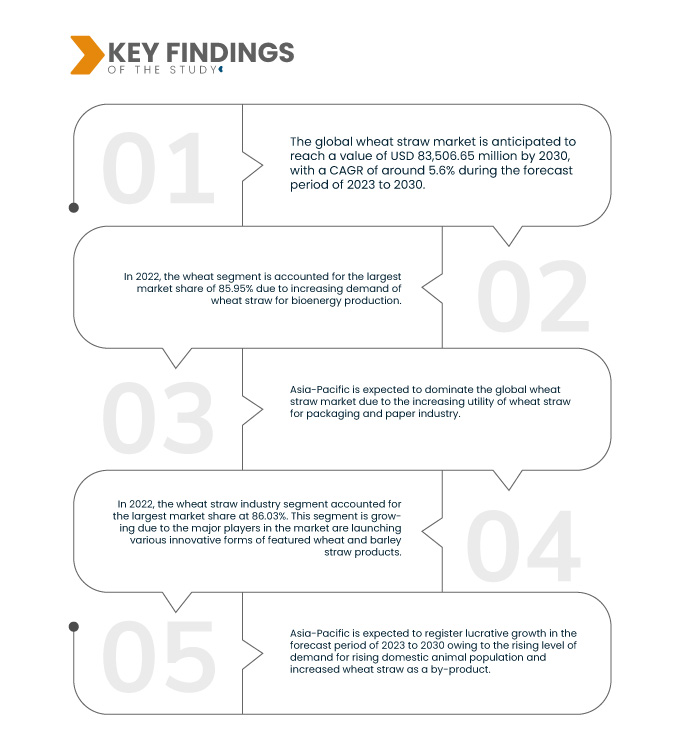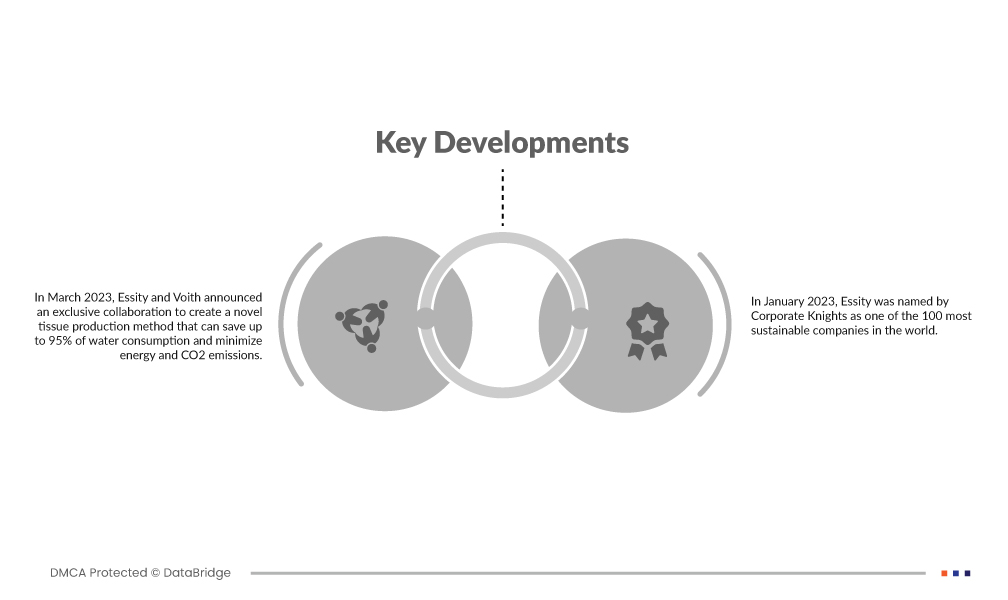There is a growing need for alternate energy sources to lessen reliance on fossil fuels. Wheat straw helps diversify energy sources and lessens dependency on non-renewable ones by offering a locally accessible and renewable resource. Following the grain harvest, wheat straw is frequently seen as an agricultural waste product. Making use of this trash as a feedstock for the production of bioenergy is an effective approach to reduce waste and add value to something that would otherwise be thrown away. Utilizing wheat straw for bioenergy has the potential to advance sustainable farming methods. Farmers can increase the overall economic sustainability of their businesses by harvesting grain for food production and using straw for electricity generation.
Access Full Report @ https://www.databridgemarketresearch.com/reports/global-wheat-straw-market
Data Bridge Market Research analyzes that the Global Wheat Straw Market is expected to grow at a CAGR of 5.6% in the forecast period of 2023 to 2030 and is expected to reach USD 83,506.65 million by 2030. The wheat segment is projected to propel the market growth due to the growing agricultural and livestock industry.
Key Findings of the Study
Increasing the Utility of Wheat Straw for Packaging and Paper Industry
With the goal of lessening its environmental impact, the paper and packaging industries are starting to place more attention on sustainability. Wheat and barley straws are appealing options for environmentally aware businesses as they precisely meet these sustainability goals due to their renewable and biodegradable nature. Straw made from wheat and barley is a sustainable source of natural fibers used to make paper and packaging. The industry lessens its need for conventional wood pulp by employing straw as a raw source, protecting biodiversity and forests.
Wheat and barley straws are frequently less expensive than standard wood pulp as they are leftovers from grain harvests. Businesses trying to maximize their manufacturing costs while achieving sustainability objectives find this cost-efficiency appealing. The sector lowers agricultural waste and advances the circular economy by using wheat and barley straw for paper and packaging, which recycles and uses resources continuously. This is in line with the larger objectives of the agricultural and industrial sectors to reduce waste.
Report Scope and Market Segmentation
|
Report Metric
|
Details
|
|
Forecast Period
|
2023 to 2030
|
|
Base Year
|
2022
|
|
Historic Year
|
2021 (Customizable to 2015-2020)
|
|
Quantitative Units
|
Revenue in USD Million, Volume in Tons, and Price in USD
|
|
Segments Covered
|
Source Type (Wheat and Barley), End Use Industry (Wheat Straw Industry and Barley Straw Industry), Distribution Channel (Direct and Indirect)
|
|
Countries Covered
|
U.S., Canada, Mexico, Germany, Italy, U.K., France, Switzerland, Spain, Russia, Turkey, Belgium, Netherlands, Norway, Poland, Denmark, Finland, Sweden, and Rest of Europe, China, India, South Korea, Japan, Thailand, Australia, Singapore, Indonesia, Malaysia, Philippines, New Zealand, Vietnam, Taiwan, and Rest of Asia-Pacific, Brazil, Argentina, Rest of South America, Saudi Arabia, U.A.E., South Africa, Egypt, Oman, Qatar, Kuwait, Bahrain and Rest of Middle East and Africa
|
|
Market Players Covered
|
Essity Aktiebolag (publ) (Sweden), Profodd Private Limited (India), Zamindara Farm Solutions Pvt Ltd (India), J. RETTENMAIER & SÖHNE GmbH + Co KG (Germany), PAILLE & FOIN (France), StrawbyStraw. (Netherlands), Brar Wheat And Rice Straw Bailing Press. (India), HINDUSTAN ANIMAL FEEDS (India), Doulière Hay France SAS (France), Holy City Straw Co. (U.S.), Burris Farms Inc. (U.S.), canopy (U.S.), Eco Green Straws (Australia), Hangzhou Prostar Enterprises Ltd. (China), among others
|
|
Data Points Covered in the Report
|
In addition to the insights on market scenarios such as market value, growth rate, segmentation, geographical coverage, and major players, the market reports curated by the Data Bridge Market Research also include in-depth expert analysis, geographically represented company-wise production and capacity, network layouts of distributors and partners, detailed and updated price trend analysis and deficit analysis of supply chain and demand.
|
Segment Analysis
The global wheat straw market is segmented based on source type, end use industry, and distribution channel.
- On the basis of source type, the market is segmented into wheat and barley.
In 2023, the wheat segment of the source type segment is expected to dominate the global wheat straw market
In 2023, the wheat segment is expected to dominate the market with a share of 85.98% due to the rising use of wheat straw in the packaging industry to make eco-friendly products.
- On the basis of end use industry, the market is segmented into wheat straw industry and barley straw industry.
In 2023, the wheat straw industry of the end use industry segment is expected to dominate the wheat straw market
In 2023, the wheat straw industry segment is expected to dominate the market with a market share of 86.09% due to a rise in product and animal feed with added supplements and nutritional values.
- On the basis of distribution channel, the market is segmented into indirect and direct. In 2023, the direct segment is expected to dominate the market with a market share of 63.25% due to enabling large-scale product sales to increase the efficiency of end-user business growth by alerting and working on the most suitable contract opportunities.
Major Players
Data Bridge Market Research analyzes Profodd Private Limited (India), Zamindara Farm Solutions Pvt Ltd (India), J. RETTENMAIER & SÖHNE GmbH + Co KG (Germany), Brar Wheat And Rice Straw Bailing Press. (India), HINDUSTAN ANIMAL FEEDS (India), as the major players of the market.
Market Development
- In March 2023, Essity and Voith announced an exclusive collaboration to create a novel tissue production method that can save up to 95% of water consumption and minimize energy and CO2 emissions. Through a unique cooperation with Voith, Essity will work with the company to develop a radical new idea that will completely rethink and revolutionize the tissue manufacturing industry. This technology allows for the manufacture of CO2-neutral tissue while consuming up to 40% less energy and 95% less freshwater than traditional papermaking methods.
- In January 2023, Essity was named by Corporate Knights as one of the 100 most sustainable companies in the world. Today, at the World Economic Forum in Davos, the list was revealed. In terms of sustainability performance, the top 1% of businesses worldwide are represented on the Global 100 ranking. Based on 25 quantifiable KPIs—such as tax income, investment sustainability, racial and gender diversity, carbon productivity, and taxes paid—the ranking is determined.
Regional Analysis
Geographically, the countries covered in the global wheat straw market report are the U.S., Canada, Mexico, Germany, Italy, U.K., France, Switzerland, Spain, Russia, Turkey, Belgium, Netherlands, Norway, Poland, Denmark, Finland, Sweden, and Rest of Europe, China, India, South Korea, Japan, Thailand, Australia, Singapore, Indonesia, Malaysia, Philippines, New Zealand, Vietnam, Taiwan, and Rest of Asia-Pacific, Brazil, Argentina, Rest of South America, Saudi Arabia, U.A.E., South Africa, Egypt, Oman, Qatar, Kuwait, Bahrain and Rest of Middle East and Africa.
As per Data Bridge Market Research analysis:
Asia-Pacific is the dominant and fastest growing region in the global wheat straw market
Asia-Pacific is expected to dominate the market owing to the higher level of investments by manufacturers and the increasing demand for better quality food in China. Asia-Pacific will continue to dominate the market in terms of market share and market revenue and will continue to flourish its dominance during the forecast period. This is due to the rising focus on sustainable farming driving the market growth. Additionally, the growing agricultural and livestock industry is propelling the market growth and is expected to further enhance the market growth rate in this region.
For more detailed information about the global wheat straw market report, click here – https://www.databridgemarketresearch.com/reports/global-wheat-straw-market












